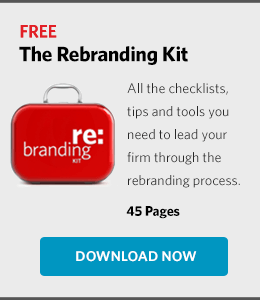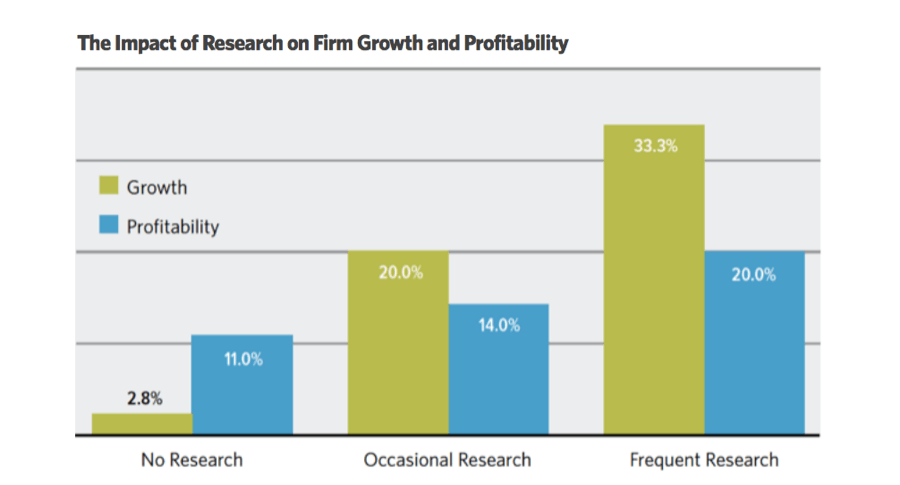Just like New Year’s, an anniversary—or other significant milestone—can be a great opportunity for reflection and to consider your firm’s next bold step.
“How is our brand design?”
“Does it reflect who we are?”
“Where have we been and where are we going?”
Whether your professional services firm is 5 years old or 100, when an anniversary rolls around, the branding discussion is often top-of-mind.
Where to Start?
A brand design discussion can start with the broad strokes of strategy, or the specifics of visuals and messaging. I like to think about brand design in the most holistic sense.
Your brand is the entire experience of how people see, interact and talk about your firm.
So a brand is not any one thing—and it is definitely not your mission or vision statement—but there are some core elements to a strong and relevant brand.
The Importance of a Strong Brand
 Strong brands have a competitive advantage. They offer:
Strong brands have a competitive advantage. They offer:
- a higher closing percentage,
- fewer competitive bid situations,
- premium fees, and
- help recruit top talent.
Strong brands also drive business and referrals for a professional services firm.
- 81.5% of firms have received a referral from people they have not worked with.*
- 46.4% of those referrals are driven by a firm’s reputation
- 48.1% of those referrals are driven by a firm’s expertise
*Source: Visible ExpertsSM: How High Visibility Expertise Helps Professionals, Their Firms, and Their Clients
Understand Your Brand
The strength of your professional services brand is measured as a combination of reputation, visibility and perceived expertise among a target audience. Before you can change your brand, you must first understand and measure those three elements.
Objectivity is required. And objectivity means research, and research drives strategy that can lead to growth and profitability.

The impact of research on growth and profitability is clear
Ideally, your research will incorporate external perspectives. But, even if you are relying on a deep internal dive, it is important to ask the right questions: Who sees or interacts with your brand? What are their interests? Can you categorize them by
- industry?
- role (CEO, CIO, human resources)?
- motivation (strategic partners, prospective employees)?
Organize your audiences by how you would interact with them. Focus on the key differences and opportunities to increase your brand’s relevance.
SEE ALSO: Rebranding Strategies: A Step-By-Step Approach for Professional Services
Do the Research
Once you’ve identified and broadly segmented your audience, it is time to gather data! Review your competitors to understand the larger market context. Then talk to current clients, prospects and even the ones that got away.
When selecting groups to interview, consider what clients you would like more of. There are always clients that help pay the bills, but they may not represent the future of your firm. Talk with clients you aspire to serve, learn about their interests and perceptions. Tweaking your brand and messaging will move you forward.
Don’t forget to consider internal perspectives . Understanding existing and future plans and priorities will help bridge the gap with external audiences and provide insights on training opportunities.
Positioning and Messaging Your Brand
After you’ve gathered your raw data, synthesize the information to get a stronger sense of how each audience segment perceives your reputation, visibility and expertise. Then think about how your firm can most effectively strengthen or change those perceptions.
You need to look at more than just what you say. Consider when you are saying it and where. The goal is to give your employees the tools they need to communicate a consistent, uniform message about your brand.
Hopefully your research revealed some clues about what sets your firm apart—what differentiates you from the competition. Just remember, to have real impact, these differentiators must be true, relevant and provable.
It may sound easy, but it isn’t. It can be difficult to meet all three criteria!
Work through each possible differentiator until you identify the most powerful ones (3-5 is a good goal). Then, and only then, it is time to consider how they can support your firm’s positioning.
Think of positioning as your firm’s North Star. It should represent the DNA of your firm and clearly explain your relevance to a client.
All audience-specific messaging and supporting collateral is developed from the foundation of your positioning statement. It should always reflect your reputation, visibility and expertise.

Research uncovers “differentiators,” which are crafted into a solid positioning statement, that flows to the masses as messaging.
Your Visual Brand
Everything your audience “sees” when interacting with your brand is part of your visual branding. There are many visual elements to your branding, but let’s focus on logos—the keystone for a firm’s visual identity.
Your logo should support your brand in three major ways: It should 1) identify and 2) differentiate you, as well as 3) aid in recall.
There are myriad logos: logotypes (word marks), monograms, abstract marks, descriptive marks, and seals. Which one (or which combination) will work for your firm is a matter of preference. The goal is to design something that will resonate strongly with your audience and support your brand.
Your Brand Toolkit
As you plan and budget to release your well researched, strategically positioned brand, make sure you’ve covered all your bases and have a realistic calendar and operational guide for your rollout. Consider how your rebrand will affect the following:
- Content marketing
- Social media
- Expertise profiles
- Marketing and pursuit materials
- Firm overview videos
- Case studies
Last but never least, your website. All brand elements must be reflected throughout the site. And since you are touching every page, a brand redesign is a perfect opportunity to update an out-of-date website.
It is a lot to develop. So start early and work methodically toward your anniversary date. Then celebrate the old and the new! Revel in the successes of the past and the possibilities of the future with a fresh new brand design.
I hope you found this starting place helpful and I’d love to hear your thoughts. Drop me a line in the comments below and let me know what you think. What’s stopping you from taking the next step with your firm’s brand?
Additional Resources
- Our Rebranding Kit gives you the tools and knowledge you need to lead your firm through a rebranding.
- Get strategies, tips, and tools for developing your firm’s brand with Hinge’s Brand Building Guide for Professional Services Firms.
- Download a free copy of the book Inside the Buyer’s Brain to learn how to build a powerful brand to help your firm close more sales.
How Hinge Can Help
Develop rebranding strategies that better connect with existing clients and prospects. Hinge’s Branding Program can help your firm stand out from the competition and build a brand that drives sustained growth.


